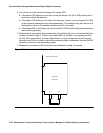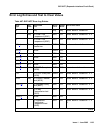
Communication Manager Maintenance-Object Repair Procedures
1186 Maintenance Procedures for Avaya Communication Manager 3.0, Media Gateways and Servers
c. This is the normal state for an active PN EI circuit pack that is also the bus master
(Expansion Archangel) in the PN.
d. This is the normal state for an active EI circuit pack that is not the bus master (Expansion
Archangel) for a PN. This applies only in the Direct Connect configuration where the EI
circuit pack in a PN is connected via a fiber link to an EI circuit pack in the other PN.
e. This is the normal state for a standby EI circuit pack in a PN.
Note:
Note: In a PN, its TN775C Maintenance (MAINT) circuit pack monitors the sanity of the
EI circuit pack. If the EI circuit pack should cycle between sane and insane
several times, the Maintenance circuit pack will hold the EI circuit pack reset. If a
new EI circuit pack is installed in the PN, and the red LED remains lit, the PN’s
Maintenance circuit pack should be removed because it may be holding the new
EI circuit pack reset. This condition could present itself if there is a link problem to
the PN, and the PN experiences several PN restarts. The Maintenance circuit
pack may be reinstalled after the EI circuit pack has been physically inserted and
the EI circuit pack’s red LED has gone off.
The link between two active EI circuit packs or between an active EI circuit pack and an active
SNI circuit pack is involved in synchronization. The EI circuit pack will report slip errors if
synchronization is not operating properly. When diagnosing synchronization problems, the EI
circuit packs should be examined as a possible cause.
EI and Tone-Clock Interactions
The viability of the EI fiber link depends upon the system clock that is provided by the active
Tone-Clock circuit pack on each network (see TDM-CLK (TDM Bus Clock)
on page 2252 and
TONE-BD (Tone-Clock Circuit)
on page 2327). Each EI circuit pack transmits over the fiber at a
rate derived from the system clock on its network. If the active Tone-Clock is defective in such a
way that the frequency of system clock it produces is out of the specified range (“out of spec”),
an EI fiber link might go down. This affects an Expansion Archangel Link (EAL), a Remote
Neighbor Link (RNL), and/or a Local Neighbor Link (LNL), even though the EI circuit packs are
healthy. When the PNC is duplicated, both fiber links could go down if there is a defective active
Tone-Clock.
Whether or not a fiber link goes down, depends on certain characteristics of the EI circuit packs.
An EI circuit pack should not be replaced if the fiber link on which it resides goes down because
of a defective active Tone-Clock circuit pack. The defective Tone-Clock circuit pack should be
replaced instead. The EI circuit packs are more sensitive to a defective system clock than the
rest of the components of the system. Therefore, testing of the Tone-Clock circuit pack might
not reveal a problem.


















